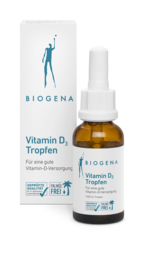Without the sun, life is impossible – this applies to plants, animals and humans alike. We need sunlight to produce the important vitamin D. Find out more about vitamin D, its production and its effect on our body here.
What is vitamin D?
Vitamin D is the generic term for a group of fat-soluble vitamins, the calciferols, which the body can produce itself, mainly through sunlight. This gives vitamin D a special position among vitamins, because its main requirement is not covered by diet, as is usually the case, but by the body's own production. We will explain more about this and what our body needs for this below.

Effects, uses and tasks: What are vitamin D benefits and what is vitamin D good for?
Vitamin D was long underestimated and was previously thought to be important only for bone health. Today, however, research knows that vitamin D is actually a hormone that plays a key role in the body. This is because it interacts with almost all cells in the body, whether in organs or tissues.
There, the active form of vitamin D – calcitriol – binds to special docking sites, known as receptors. Once it is bound, it supports various important processes and functions in the body, such as the absorption of calcium and phosphorus from food through the intestines. It is also involved in the maintenance of muscles, bones and teeth and supports the function of the immune system.
A vitamin D deficiency can also have far-reaching consequences and is associated with cardiovascular complaints, high blood pressure, diabetes, depression and an unhealthy aging process.
Therefore, an adequate and stable vitamin D balance has a major influence on human well-being.
Vitamin D & immune system
Vitamin D plays a key role in our immune system. The sunshine vitamin is not only involved in the production of immune cells and immune-regulating proteins, it also influences various immune cells (e.g. macrophages, B and T lymphocytes) and is involved in the regulation of inflammatory processes. While a weak immune system gains strength from vitamin D, excessive immune reactions, such as allergies or autoimmune diseases, can be alleviated by it.
Good to know in winter: less vitamin D, more infections
For a long time, it was a mystery to experts why waves of colds occur during the dark season. We now know that the epidemic-like vitamin D deficiency among the population is a driving force behind this.
This is because vitamin D is in short supply in our latitudes during the winter. After all, due to the low angle of the sun from about mid-October to mid-March, no significant vitamin D formation is possible. Accordingly, 91% of the participants in the BIOGENA Good Health Study did not have an optimal vitamin D supply when their blood was tested in spring, and 48% even had severe vitamin D deficiency. Insufficient vitamin D levels significantly increase the risk of upper respiratory tract infections in autumn and winter, and according to an Austrian study, there is also a correlation between the frequency of illness among employees with a poor or sub-optimal vitamin D supply.
To survive the cold and flu season in good health, you should start taking a high-quality vitamin D supplement during the dark winter months at the latest.
Wäger et al. 2022. BIOGENA Good Health Study: Vitamin D. unpublished.
Sinnißbichler T., Viebahn I. 2011. Vitamin D sought - deficits found. 25-(OH)-Vitamin D status, supplementation and sick days. unpublished.
Vitamin D & fatigue
There are many causes of tiredness. Not least, it can also be caused by a vitamin D deficiency. According to a study, anyone who wants to combat fatigue caused by a deficiency should take vitamin D supplements. 120 healthy people of different ages who had vitamin D deficiency and were also complaining of tiredness took part in the study. The participants who – without knowing it – were given vitamin D reported a decrease in their fatigue at the end of the intake period.
Vitamin D & bones
It has been known for a long time that vitamin D is essential for healthy bones. The sunshine vitamin not only ensures that calcium is absorbed from the intestines, but it also regulates the storage of the mineral in the bones. It is no wonder that a good vitamin D supply throughout the year is an important preventive step in preventing osteoporosis. But the ‘bone vitamin’ is not only indispensable in the prevention of osteoporosis, it is also essential in its treatment. Effective bone supplements provide not only vitamin D but also other relevant nutrients (e.g. calcium, magnesium, vitamin K).
Vitamin D daily dosage recommendation: How much vitamin D per day?
The German Nutrition Society recommends 20 µg or 800 I.U. of vitamin D daily as an estimate for an adequate intake for children, adolescents and adults. Due to the widespread inadequate supply of vitamin D in the population and the many advantages of higher vitamin D levels, higher dosages provide clear health benefits. The safe maximum daily amount of vitamin D is 100 µg or 4000 I.U.
| Age | Adequate vitamin D intake in the absence of endogenous synthesis |
| Infants up to 12 months old | 10 in µg/day |
| Children up to 14 years | 20 in µg/day |
| Young people and adults aged 15 and over | 20 in µg/day |
| 65 years and older | 20 in µg/day |
| During pregnancy | 20 in µg/day |
| During breastfeeding | 20 in µg/day |
Table 1: Recommended daily vitamin D intake according to the DGE
Vitamin D Test: measure your own blood levels
To determine vitamin D levels, the amount of 25-hydroxyvitamin D3 in the blood is measured and, depending on the laboratory, is given either as nmol/l or as ng/ml.
BIOGENA Good Health Study: Vitamin D – the underrated hormone
Vitamin D is the only nutrient that is not obtained from food, but primarily from the body's own synthesis using sunlight. Nevertheless, studies such as the BIOGENA Good Health Study repeatedly show that vitamin D stores in the population are depleted. The Good Health Study examined the supply situation of 1377 Austrian participants and came to the following conclusion regarding vitamin D status throughout Austria.
Vitamin D levels: normal levels & deficiency
What are normal and optimal vitamin D levels, and when do I have a deficiency? The following table is intended to help you decipher the ‘laboratory lingo’.
|
Assessment of the status |
25-hydroxy-D serum levels (nmol/L) |
25 hydroxy vitamin D serum level (ng/ml) (-> equivalent to "μgl/L") |
|
Serious deficiency |
< 50 nmol/l |
< 20 ng/ml |
|
Slight deficiency |
50–75 nmol/l |
20 – 30 ng/ml |
|
Sufficient supply |
75–100 nmol/l |
30 – 40 ng/ml |
|
Optimal supply |
100–150 nmol/l |
40 – 60 ng/ml |
Table 2: Vitamin D levels and classifications
* Conversion from nmol/l to ng/ml: Simply divide the value in nmol/l by 2.5.
Vitamin D deficiency: low vitamin d symptoms
Our bodies are able to produce vitamin D themselves with the help of sunlight. However, there are numerous disruptive factors, such as cold, older age, a darker skin type or the use of sun protection factors, which can stand in the way of sufficient vitamin D formation.
How to ensure an adequate supply
The intake of vitamin D through normal food only makes a small contribution to the vitamin D supply. As a rule, 80–90% of the vitamin can be produced by the body itself in the skin with the help of sunlight (UV-B rays). This requires time spent outdoors, with the body's own production varying from person to person.
Vitamin D production: synthesis in the skin – optimised by nature
The starting substance for vitamin D production in the body is the provitamin 7-dehydrocholesterol. When UV-B rays hit the skin, previtamin D3 is initially formed. This is then converted into vitamin D3, which is also known as cholecalciferol or simply vitamin D. Vitamin D3 can be metabolised into its storage form, calcidiol, and finally into its physiologically active form, the hormone calcidiol. It is in this active form that it can perform its functions in the body.
Difference between vitamin D and D3
The term ‘vitamin D’ refers to a group of fat-soluble vitamins known as calciferols. Vitamin D3, also known as cholecalciferol, is the most important form for the human body within the calciferols.
Optimal conditions and influencing factors for self-synthesis
In our latitudes, the optimal conditions for vitamin D formation are between April and September, during the period from 10 a.m. to 3 p.m. Ideally, a quarter of the skin (face, hands, parts of arms and legs) should be exposed to the sun without sunscreen for 5 to 25 minutes (depending on the season and skin type) every day. It is essential to pay attention to the skin's self-protection time and to avoid sunburn!
Note: Approx. half of the time that would otherwise be needed to get an unprotected sunburn is enough. If you spend a long time in the sun, you should definitely use sun protection.
The synthesis of vitamin D in the skin is highly dependent on the UV-B index, which only reaches the required value of more than 3 at the correct position and angle of the sun, which corresponds to UV-B radiation of 290–315 nm.
A simple rule for remembering: if the shadow is longer than you are, you will not be able to synthesise sufficient vitamin D! From October to March, the sun is lower in the sky and the UV index is below 3. At these times, the body draws on its vitamin D stores, provided these have been sufficiently replenished over the summer.
Other factors besides latitude, season and time of day and weather conditions include skin type, clothing, length of time spent outdoors and the use of sunscreen.
What are vitamin D rich foods?
Vitamin D can also be obtained from food, although significant amounts are only found in a few foods, mostly of animal origin, such as fatty fish (salmon, herring), liver, egg yolk and some edible mushrooms.
According to the DGE, the intake from the usual foods is not sufficient to reach the estimated value for an adequate intake of 20 µg vitamin D per day if the body does not produce any vitamin D itself. The difference must be covered by the body's own production and/or by taking a vitamin D supplement.
Vitamin D intake and dosage
According to the D-A-CH nutrition societies, people who, for various reasons, spend little or no time outdoors when the sun is shining, or only go out in the sun with their bodies completely covered, as well as people with dark skin pigmentation, are recommended to take a vitamin D supplement.
When to take vitamin D: morning or evening?
Whether it's morning, noon or evening, the time of day is less important than how you take your vitamin D supplements. Preparations that do not contain oils as an additional ingredient are best consumed with a meal. Some experts recommend taking the sunshine vitamin with the most substantial meal of the day (usually lunch or dinner). In any case, the food should provide some fat to aid vitamin D absorption.
How do you take vitamin D?
Since vitamin D is fat-soluble, fatty foods (e.g. high-quality oils) improve its absorption into the body. For this reason, vitamin D should always be taken with food. Exceptions to this are preparations in which the vitamin has already been combined with a fat component (such as vitamin D drops).
How much vitamin D per day is recommended?
The German Nutrition Society (DGE) recommends 20 µg or 800 I.U. of vitamin D daily as an estimate for an adequate vitamin D intake in the absence of self-synthesis (e.g. in winter, when working full-time indoors or when bedridden). Due to the widespread inadequate supply of vitamin D in the population and the many benefits of higher vitamin D levels, higher dosages provide clear health benefits. The safe maximum daily amount of vitamin D is 100 µg or 4000 I.U.
If higher dosages are being considered, regular blood tests are recommended. The selected dosage should also be adjusted to your own body weight; online vitamin D calculators can help you choose the right dosage, including the desired dosage period.
When is high-dose vitamin D3 useful?
High-dose vitamin D3 is often used when vitamin D levels are very low, to rectify the deficiency as quickly as possible. Some doctors also prefer high-dose vitamin D3 for maintenance therapy, as the supplement needs to be taken much less frequently and is therefore considered more convenient by some patients.
How long should you take vitamin D for?
In general, a year-round intake of vitamin D is recommended. People who suffer from a vitamin D deficiency should ideally take higher amounts of vitamin D under medical supervision and with laboratory diagnostics monitoring – until they have reached their target level. However, it can take several weeks or even months.
Vitamin D supplements: drops, capsules or tablets?
If you decide to supplement the sunshine vitamin in your daily life, you are spoilt for choice: drops, capsules and tablets are probably the most common on the market – but which preparation is best?
First things first: there is no such thing as the ultimate vitamin D supplement for everyone. However, when making a purchase decision, the quality of the supplement (e.g. a formulation that is as free as possible from additives, a trustworthy quality manufacturer) and the correct dosage should always be at the forefront of your mind.
The advantage of vitamin D drops is that the fat-soluble vitamin is already dissolved in the oily environment and can therefore be easily absorbed by the body. For the consumer, this means that they can take the drops at any time, regardless of meals. Drops are also convenient to take and can be individually dosed. Less ideal is the often shorter shelf life of drops compared to capsules or tablets.
The most common form of vitamin D on the market is in tablet form. Here, too, there are variants in which oil is included for improved vitamin D absorption. However, many tablet products not only contain active ingredients, but also unnecessary additives (such as colourings and flavourings) and are therefore less advisable.
Vitamin D capsules often impress with their particular purity, since capsules usually do not require additives. They are hygienic and have a relatively long shelf life even without additives. Preparations that do not automatically include oil should always be taken with a fatty meal to allow the vitamin to be properly absorbed into the body.
Why combine vitamin D3 with K2?
A combination of vitamin K2 and vitamin D3 is definitely useful in certain situations. In particular when it comes to hard graft on the bone, both vitamins work together. Vitamin K2 has the task of storing the minerals in the bones – but for this vitamin D3 must activate the necessary proteins and also utilise the calcium. If there is a lack of vitamin K2, calcium and magnesium cannot be ‘channeled’ into the bones. If there is insufficient vitamin D3, there is a lack of proteins and usable calcium for bone mineralisation. Both fat-soluble vitamins are therefore essential in effective bone supplements.
Vitamin D and magnesium
Vitamin D and magnesium work together at different levels in metabolism, which can make a combination of the two useful in certain settings. For example, vitamin D aids the absorption of magnesium in the gut, and adequate vitamin D levels can generally improve magnesium absorption. Both vitamin D and magnesium influence bone, tooth and muscle health. Studies suggest that a deficiency of vitamin D and magnesium can favour the development of high blood pressure. People with high blood pressure may be advised to have the status of both nutrients checked and, if necessary, to take supplements.
Conclusion: Vitamin D should be on all our minds and on our lips. After all, vitamin D receptors can be found in almost all organs and tissues – a synonym and reflection of its health relevance. Studies such as the BIOGENA Good Health Study show that in many cases, a healthy diet and exposure to sunlight are not enough to ensure good vitamin D levels; an additional supply of vitamin D in the form of a supplement is also necessary. Due to the health benefits, the aim should be not just an adequate vitamin D supply, but an optimal one, under laboratory diagnostic supervision.
Vitamin D and magnesium
Vitamin D and magnesium work together in the metabolism at different levels, which can make a combination of both under certain settings quite useful. Vitamin D, for example, supports the absorption of magnesium in the intestine, whereby an adequate level of vitamin D can generally improve magnesium absorption. Both vitamin D and magnesium contribute to the health of bones, teeth and muscles. Studies indicate that vitamin D and magnesium deficiency can promote the development of high blood pressure. People with high blood pressure can be encouraged to have the status of both nutrients checked and supplemented if necessary.
Frequently asked questions about vitamin D
Vitamin D and vitamin B12 can be taken together without any problems. The two vitamins do not interfere with each other's absorption or further metabolism.
Vitamin D and vitamin K2 do not always have to be taken together. However, depending on the individual situation and therapeutic goal, taking both vitamins together can be useful or even highly beneficial. Vitamin K2 and vitamin D3 work together to build and maintain strong bones.
Vitamin D drops are easy for anyone to take and automatically provide the body with fat (oil), which it needs as a transport medium to absorb the fat-soluble vitamin well. Those who prefer tablets or capsules should choose products that are as free as possible from additives and take the vitamin with a fat-containing meal.
Vitamin D is found in appreciable amounts in a small selection of foods. The frontrunners include fatty fish such as wild salmon, herring and eel, as well as liver and cod liver oil. Smaller amounts of vitamin D are found in egg yolks, liver and some wild mushrooms, such as porcini or chanterelles.
In practice, it is not possible to meet the daily vitamin D requirement through food. By far the most vitamin D is found in fatty fish, such as salmon and herring. To a far lesser extent it is found in liver, egg yolks and some fungi, such as chanterelles and wild mushrooms.
Based on current data (*), an average of 40% of the population in Europe is insufficiently supplied with vitamin D. In Germany alone, however, the annual average is 56% (reference laboratory value of <50 nmol/l). Independent expert groups and physicians, on the other hand, recommend a higher reference laboratory value of 75 nmol/l. If we use this as a reference, then in Germany over 85%, in Switzerland 75%, in the Netherlands approx. 70% and in the UK approx. 88% are underserved. Even more southerly regions of Europe are not spared from vitamin D deficiency; data from Greece, for example, show that up to 90% of the population there are insufficiently supplied with vitamin D (based on 75 nmol/l) and about 50% are below a value of 50 nmol/l.
* Cashman KD et al. 2016. Vitamin D deficiency in Europe: pandemic?. Am J Clin Nutr. 103(4): 1033–1044.
Palacios C und Gonzalez L. 2013. Is vitamin D deficiency a major global public health problem? J Steroid Biochem Mol Biol. 144PA: 138–145.
The human body produces 80–90% of vitamin D with the help of sunlight. UVB radiation is essential for this. The UVB radiation contained in sunlight first converts a form of cholesterol in the outer layer of skin into previtamin D3 and then converts this into vitamin D3. The body then has to convert the vitamin D3 that has been created in this way into its storage form calcidiol or its active form, the vitamin D hormone calcitriol, via metabolic pathways.
Sources:
Gröber, U. 2010. Vitamin D3, an old vitamin in a new light. Med Monatsschr Pharmazeut. 33(10):376–83. https://pubmed.ncbi.nlm.nih.gov/21072911/
Bikle, D. D. 2014. Vitamin D metabolism, mechanism of action, and clinical applications. Chem Biol. 21(3):319–29. https://pubmed.ncbi.nlm.nih.gov/24529992/
Theodoratou, E. et al. 2014. Vitamin D and multiple health outcomes: umbrella review of systematic reviews and meta-analyses of observational studies and randomised trials. BMJ. 348: g2035. https://pubmed.ncbi.nlm.nih.gov/24690624/
Schoenmakers, I. et al. 2015. Prediction of winter vitamin D status and requirements in the UK population based on 25(OH) vitamin D half-life and dietary intake data. J Steroid Biochem Mol Biol. 1–5. https://pubmed.ncbi.nlm.nih.gov/26970588/
Black, L. J. et al. 2015. Analytical Bias in the Measurement of Serum 25-Hydroxyvitamin D Concentrations Impairs Assessment of Vitamin D Status in Clinical and Research Settings. PLoS One. 10(8): e135478. https://pubmed.ncbi.nlm.nih.gov/26266807/
Khashayar, P. et al. 2016. Vitamin D status and its relationship with bone mineral density in a healthy Iranian population. Rev Bras Ortop. 51(4):454–8. https://pubmed.ncbi.nlm.nih.gov/27517026/
Nieves, J. W.Skeletal effects of nutrients and neutraceuticals, beyond calcium and vitamin D. Osteoporos Int. 24(3):771–86. https://pubmed.ncbi.nlm.nih.gov/23152094/
Wäger et al. 2022. BIOGENA Good Health Study: Vitamin D
Nowak, A. et. Al. 2016. Effect of vitamin D3 on self-perceived fatigue. A double-blind randomized placebo-controlled trial. Medicine (Baltimore). 2016 Dec; 95(52): e5353. https://pubmed.ncbi.nlm.nih.gov/28033244/
https://flexikon.doccheck.com/de/Calcidiol Zugriff: 11.1.2024
Nelson, M. L. et al. 2009. Supplements of 20 microg/d cholecalciferol optimized serum 25-hydroxyvitamin D concentrations in 80 % of premenopausal women in winter. J Nutr. 139(3):540-6. doi: 10.3945/jn.108.096180. https://pubmed.ncbi.nlm.nih.gov/19158226/
Holick, M. F. 2004. Sunlight and vitamin D for bone health and prevention of autoimmune diseases, cancers, and cardiovascular disease. Am J Clin Nutr. 80(6 Suppl):1678S-88S. https://pubmed.ncbi.nlm.nih.gov/15585788/
Sinnißbichler, T., Viebahn, I. Vitamin D sought - deficits found. Biogena study 2011.
Gröber, U. Orthomolecular Medicine: A Guide for Pharmacists and Physicians, 3rd unchanged edition. Stuttgart: WVG Wissenschaftliche Verlagsgesellschaft Stuttgart, 2008.
Borissova, A. M. et al. 2003. The effect of vitamin D3 on insulin secretion and peripheral insulin sensitivity in type 2 diabetic patients. Int J Clin Pract. 57(4):258-61. https://pubmed.ncbi.nlm.nih.gov/12800453/
Mitri, J., Pittas, A. G. 2014. Vitamin D and Diabetes. Endocrinology and Metabolism Clinics of North America. 43(1), 205–232 https://pubmed.ncbi.nlm.nih.gov/24582099/
Dobnig, H. et al. 2008. Independent association of low serum 25-hydroxyvitamin D and 1,25-dihydroxy vitamin D levels with all-cause and cardiovascular mortality. Arch Intern Med. 168:1340-9. doi: 10.1001/archinte.168.12.1340. https://pubmed.ncbi.nlm.nih.gov/18574092/
Aloia, J. F., Li-Ng, M. 2008. Epidemic influenza and vitamin D (letter). Epidemiol Infect. 135:1095-6. https://pubmed.ncbi.nlm.nih.gov/17352842/
Sundaram, M. E., Coleman, L. A. 2012. Vitamin D and Influenza. Advances in Nutrition: An International Review Journal. 3(4): 517-525. doi: 10.3945/an.112.002162. https://pubmed.ncbi.nlm.nih.gov/22797987/
Smolders, J. et al. 2008. Vitamin D as an immune modulator in multiple sclerosis. A Review. J Neuroimmunol. 194(1-2):7–17. https://pubmed.ncbi.nlm.nih.gov/18177949/
Lemke, D. 2011. Effect of vitamin D on nerves and brain. Vitamin D Update at the Charité, Berlin April 2011.
Xie, F. et al. 2022. Effect of vitamin D supplementation on the incidience and prognosis of depression: An updated meta-analysis based on randomized controlled trials. Front Public Health. 10:903547. https://pubmed.ncbi.nlm.nih.gov/35979473/
Cranney, A. et al. 2007. Effectiveness and safety of vitamin D in relation to bone health. Evid Rep Technol Assess. (158):1–235. https://pubmed.ncbi.nlm.nih.gov/18088161/
Dobnig, H. 2011. Wirkung von Vitamin D auf Muskulatur und Fitness. Vitamin D Update an der Charité, Berlin April 2011.
Navale, S. S. et al. 2022. Vitamin D and brain health: an oberservational and Mendelian randomization study. Am J Clin Nutr. nqac107. oi: 10.1093/ajcn/nqac107. https://pubmed.ncbi.nlm.nih.gov/35451454/
Gröber, U. Medicines and micronutrients: Medication-oriented supplementation, 3rd updated and expanded edition. Stuttgart: WVG Wissenschaftliche Verlagsgesellschaft Stuttgart, 2014.
https://www.dge.de/wissenschaft/referenzwerte/vitamin-d/ Zugriff: 04.12.2024











